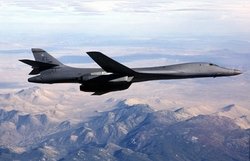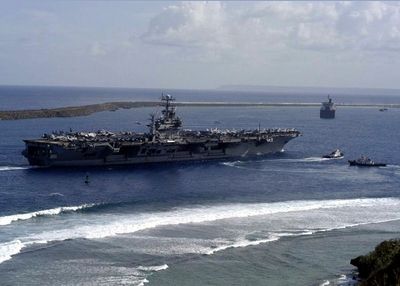First Appearance In Gulf Since 1998
 For the first time since 1998, American forces
sent a B-1 bomber over Iraq Friday, where it targeted two radar
sites in the western part of the country. The United States usually
uses fighter jets to patrol and bomb targets in Iraq's two no-fly
zones.
For the first time since 1998, American forces
sent a B-1 bomber over Iraq Friday, where it targeted two radar
sites in the western part of the country. The United States usually
uses fighter jets to patrol and bomb targets in Iraq's two no-fly
zones.
Friday's airstrikes, using precision-guided weapons, were aimed
at mobile radar systems. Military officials say Iraq moved the
radar equipment into the southern no-fly zone about 370 kilometers
west of Baghdad, not far from the border with Jordan. The
highly-mobile radar systems are used in association with
surface-to-air missiles.
Ships Move To Missile Launch Points
The Pentagon has started moving warships from the eastern
Mediterranean to the Red Sea, to reach a point where any cruise
missiles launched at Iraq would pass only through Saudi airspace.
The move was prompted by Turkey's refusal to grant over-flight
rights to U.S. aircraft and cruise missiles in a possible war with
Iraq.
Twelve vessels in all may be on the move - among them, two
aircraft carriers, the USS Harry S Truman and the USS Theodore
Roosevelt.

Meanwhile, On The Other Side Of The World...
 For the first time in 10 years, the Air Force
brought its premier stealth fighter to Foal Eagle, the largest
U.S.-South Korean military war game that practices defense against
a North Korean attack. Six F-117A Nighthawks — “Stealth
Fighters” — from Holloman Air Force Base, N.M., arrived
at Kunsan Wednesday after 11 refuelings over the Pacific Ocean and
a stop at Hickam Air Force Base, Hawaii.
For the first time in 10 years, the Air Force
brought its premier stealth fighter to Foal Eagle, the largest
U.S.-South Korean military war game that practices defense against
a North Korean attack. Six F-117A Nighthawks — “Stealth
Fighters” — from Holloman Air Force Base, N.M., arrived
at Kunsan Wednesday after 11 refuelings over the Pacific Ocean and
a stop at Hickam Air Force Base, Hawaii.
The $45 million fighter — a pillar of pride during the
1991 Gulf War for penetrating the heavily defended skies over
Baghdad — arrives in a tense environment. On March 2, North
Korean fighters chased an RC-135S spy plane over the Sea of Japan.
North Korea also recently fired two anti-ship missiles during
military exercises.
U.S. military officials have stressed that the fighters’
arrival isn’t in response to North Korean threats. But the
stark warplane on display at Kunsan appeared to awe journalists and
visitors Friday; they clamored for pictures and interviews with
pilots.
The planes will stay for two weeks, taking off in pairs and
splitting up for flight training. Officials have not determined if
they will drop ordnance on South Korea’s training ranges.
Pilots are planning day and night sorties, as most wartime attacks
would occur under darkness.
The F-117A’s angular design is its only protection,
snuffing radar waves. It has no weapons to protect itself from
enemy fighters and usually carries just two laser-guided bombs for
its target.
“They designed a weapon system that is low-observable to
enemy radar and to many other spectrums,” Lake said.
“While we would probably use different tactics in the old
days to get the same job done, now we do that through our
low-observable technology and the tactics associated with
those.”
The plane isn’t invisible to radar but is “very hard
to see,” said Maj. Jose Angel Pinedo, another pilot.
If You Can't See 'Em, You Can't Shoot 'Em
 “Our defense is stealth technology,”
Pinedo said. “The whole idea is for them not to be able to
see us.”
“Our defense is stealth technology,”
Pinedo said. “The whole idea is for them not to be able to
see us.”
During war, the fighter is assigned high-value targets heavily
defended by enemy radar. But the stealth fighter hasn’t been
foolproof, as one was downed during the Kosovo air campaign in
1999.
Maj. Lee Wyatt flew missions in the F-117A from Aviano Air Base,
Italy, during the Kosovo conflict. The fighter really is no safer
or more dangerous than any other plane, said Wyatt, who also has
flown the A-10 Thunderbolt II, a subsonic tank killer.
“All the missions are different and they all have their
dangers,” Wyatt said. “I certainly knew a lot more
people who were killed flying A-10s just in training than were
killed in this airplane. That’s not something I really think
about, and that’s not really how I think about it. You train
to do a mission, and you do it.”
Before climbing into the F-117A, pilots log many years in other
fighter planes. Maj. Mark Hoover was an F-16 pilot.
“It’s not as maneuverable as an F-16,” Hoover
said. “It’s not an air-to-air fighter. Its entire
purpose in life is precision attack versus dogfighting.”
Pilots: Confident F-117s Will Bring 'Em Back Alive
“I’d be confident that I’d be coming
back,” Pinedo said. “But there’s no such thing as
a risk-free mission in combat.”) - A U.S. aircraft carrier
prepared to take part in U.S.-South Korean war games on Saturday,
which North Korea described as a rehearsal for a nuclear attack,
ratcheting up tensions over the reclusive communist state's nuclear
program.
Impoverished North Korea, which has taken a series of provocative
steps on the Cold War's last flashpoint over the past few months in
its campaign for direct talks with Washington, took a dire view of
the annual month-long exercises.
"The U.S. seeks to round off its preparations for a nuclear war
against the DPRK (North Korea) at its final phase and mount a
pre-emptive nuclear attack on it any time," Pyongyang's state-run
newspaper Rodong Shinmun said on Saturday.

"Deterrence And Influence"
American military muscle has gone on full display in the South
as the aircraft carrier USS Carl Vinson was sent to the western
Pacific after U.S. forces deployed those six F-117A warplanes this
week. The U.S. Air Force also prepared to resume spy flights off
the coast of North Korea.
The Carl Vinson, moored just outside the breakwater of Pusan
harbor for a few days with 70 aircraft and eight squadrons, will go
to sea to support U.S.-South Korean forces.
"Our primary mission is deterrence and influence," Navy Captain
Richard B. Wren, the ship's commanding officer told a pool of
reporters.
"Our presence in the region is not in direct response on North
Korea, but certainly our presence can also be an influence," Wren
said.
The crisis on the Korean peninsula has been simmering since
October, when U.S. officials said North Korea had admitted to a
nuclear weapons program.
Tensions have escalated since then. Over the last month, North
Korea has intercepted a U.S. reconnaissance plane patrolling
international airspace and test-fired two short-range missiles,
while a Japanese report said the North may soon test-fire a
longer-range missile that could reach Japan.
 ANN's Daily Aero-Term (10.31.25): Minimum Sector Altitude [ICAO]
ANN's Daily Aero-Term (10.31.25): Minimum Sector Altitude [ICAO] ANN's Daily Aero-Linx (10.31.25)
ANN's Daily Aero-Linx (10.31.25) NTSB Final Report: Airbus A321-271N (A1); Cessna 172N (A2)
NTSB Final Report: Airbus A321-271N (A1); Cessna 172N (A2) ANN FAQ: Follow Us On Instagram!
ANN FAQ: Follow Us On Instagram! Airborne 10.30.25: Earhart Search, SpaceX Speed Limit, Welcome Back, Xyla!
Airborne 10.30.25: Earhart Search, SpaceX Speed Limit, Welcome Back, Xyla!







